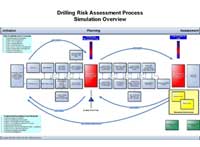Managing risk in an uncertain world: new techniques
Empowering the decision maker
In the Fall of 2008, markets across the world unravelled at a blazing speed, driven by a very high Velocity of Information (VI). Rapid Response Management: Thriving in the New World Order, VI is similar to the economic theory, Velocity of Money; it is the frequency at which information is exchanged. These implosions spared almost no individual, company, country, or geographical region. This Black Swan, or extreme outlier event blew apart many of the Monte Carlo financial models used by many to manage risk, exposing structural weaknesses about how we manage our businesses.
We can expect volatility to continue and management techniques honed in last century’s markets may prove woefully inadequate going forward. Fortunately, 21st century tools are available today. Would it surprise anyone to know that events of 2008 were foretold in 2005 by computer simulation of possible scenarios? They were! Run by senior US officials, Oil Shockwave 2005 ‘gamed’ global economic impacts of high oil prices. Armed with these publicly available results, why were governments, pundits, and corporate executives caught so off guard?
The age of ambiguity
How many of us have sat in meetings where we identified the best case, worst case, and medium or likely (hoped for) case? Most will answer yes to that question for this is how we are trained to make decisions. We seek to reduce a myriad of subjective knowledge as well as data and information into a manageable set. Moreover, when communicated to management, major decision recommendations are boiled down to a short deck of slides. This approach may not pick up the outlying ‘once in a lifetime’ events that seem to plague us on a much more frequent basis. Creating new options, questioning possible unintended consequences, and gaming scenarios sheds a brighter light, minimising ambiguity and uncertainty.
Drilling risk assessment modelling
CAPEX projects are very expensive, often long-term by nature, and increasingly the Return on Investment (ROI) is elusive. The old adage, ‘measure many times, cut once,’ is true for carpenters, laying the keel on an FPSO, or a major drilling programme. It is much less expensive to model complex processes on a computer before committing to cutting or in the case of drilling, turning to the right. The industry does this in other areas, most notably reservoir simulation modelling. Historically, simulation tools were quite expensive and difficult to use. This is no longer the case.

Working with a global operator, a Drilling Risk Assessment simulation model has been developed. This model is built around Project Management Institute (PMI) Body of Knowledge or PMBOK and is therefore consistent with the PMBOK Project Risk Management Knowledge Area Process. The process flow is in the following diagram and is driven by a Systems Dynamics based inference engine.
Executives can now ‘simulate many times’ and test scenarios before committing and ‘turning to the right.’ Risk mitigation for operators and their supply chain partners is robust and more fully able to model the possible impact of Black Swan events as well as the more normal 2? confidence interval of the traditional statistical normal distribution.
Author: Dr. Scott M. Shemwell
Dr. Scott M. Shemwell is an acknowledged authority and thought leader in field operations and risk management with over 30 years in the upstream energy services sector. He had been directly involved in over US$ 5 billion acquisition and divestitures as well as the management of significant projects and business units.
Read the article online at: https://www.oilfieldtechnology.com/exploration/05102009/managing_risk_in_an_uncertain_world_new_techniques/
You might also like
Union Jack Oil plc sign farm-in agreement with Reach Oil and Gas for the Sark Drilling Project
The agreement is to acquire a 60% working interest (paying 80%) in the Sark well, planned to be drilled early 3Q25, located in Central Oklahoma, US.

